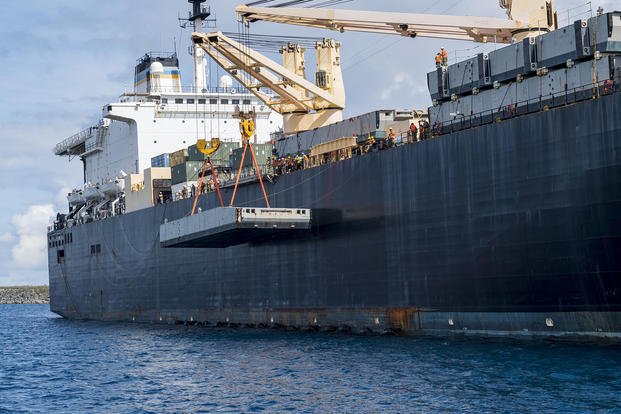The Navy revealed that one of the ships it deployed to support the mission of building a pier to deliver aid to starving residents in Gaza was forced to turn back last week after it suffered a fire in its engine room.
The incident comes as the Pentagon's self-imposed deadline of having the pier operational and delivering the needed aid by May rapidly approaches, and experts say there are other delays and problems cropping up with the mission.
The USNS 2nd Lt. John P. Bobo "experienced a fire in the engine room while in transit to the eastern Mediterranean Sea" on April 11, and while the crew evacuated the area and used portable extinguishers to put out the fire, the ship had to return to Jacksonville, Florida, using just one engine, "for further assessment," according to a Navy statement provided Wednesday.
Read Next: Air Force Identifies Seemingly Higher Rate of Rare Brain Cancer Among Children at New Mexico Base
When the Pentagon first announced the plan to use the Joint Logistics Over-the-Shore, or JLOTS, platform to construct the pier that would serve as a way to quickly deliver large amounts of aid to war-torn Gaza in early March, spokesman Maj. Gen. Pat Ryder said the pier would be operational in the next 60 days.
Shortly after that announcement, a group of five Army ships left for the Mediterranean, followed by the MV Roy P. Benavidez, a military sealift command vessel that was carrying "heavy equipment and material needed to construct a temporary pier," according to a statement.
Finally, in late March, the Navy said that it would deploy Naval Beach Group 1 along with the Bobo and the USNS 1st Lt. Baldomero Lopez. The unit and the ships would bring enough watercraft and equipment to operate a huge floating dock three miles off the coast of Gaza that would serve as the off-load point for aid.
Now, more than a month later, not all of the ships in the flotilla have made it to the Mediterranean, a tracker run by USNI News shows.
Sal Mercogliano, an academic and shipping expert, noted to Military.com on Wednesday that one of the Army Landing Craft Utility ships, the Wilson Wharf, seems to be stuck in Tenerife -- a small island that is part of the Canary Islands cluster off the west coast of Africa. Plus, the Army's Logistics Support Vessel General Frank S. Besson spent a week in the Azores before finally making it to the Navy's base at Souda Bay in Greece.
Mercogliano said such a long stay may indicate the ship had an engineering issue.
A retired Army chief warrant officer who has significant experience in the Army's watercraft community also told Military.com in an interview Wednesday that "if those boats don't have multiple major mechanical failures -- I mean 'dead in the water' mechanical failures -- I will be shocked."
"They're horrendously maintained. I've got videos of these things falling apart," the retired officer added.
According to the officer, the delays of the Bobo and the smaller Army ships mean "they're going to have a lot fewer pieces to work with as far as building the actual pier."
"The other rub point ... is security arrangements," the officer said, noting that "these boats have next to no security."
"You've got a couple of .50 cals and small arms ... and the vessel masters are not taught maritime tactics," the officer explained.
When asked about the safety of the vessels, Ryder told reporters Tuesday that there will be "some Israeli support when it comes to the maritime aspect of security" and noted that the Navy's 6th Fleet has "capabilities there as well."
Ryder also added some nuance to the 60-day goal that he laid out at the beginning of March.
The Pentagon spokesman told reporters that the Defense Department is "still on track to have JLOTS achieve operating capability by the end of the month or early May" but went on to draw a distinction between an initial operational capability and full operational capability.
"Right now, we're tracking that it will be operational, which means it will have some initial operating capability, by the end of the month or early May," he said.
Ryder said the construction of the two piers will probably begin "in the next two to three weeks."
Related: Navy Deploying Ships, 260 Sailors to Help Operate Gaza Aid Pier











